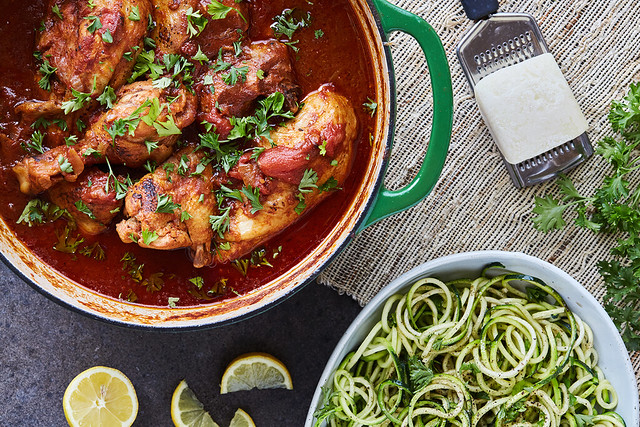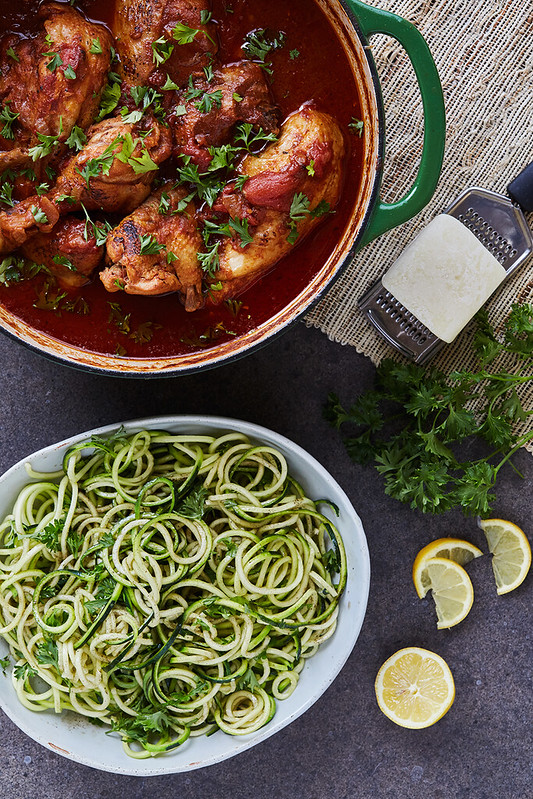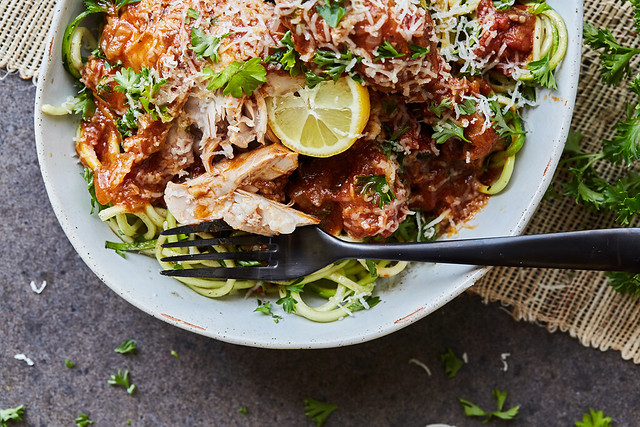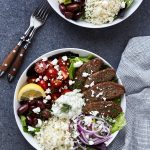I don’t have the best memory, I never have. I forget things easily, but my memories surrounding foods and scents, especially with family – those are strong. I still remember the very distinct aromas of my Great Yia Yia’s home. The basement often smelled of chocolate, the living room of butterscotch candies and the kitchen, of so many amazing Greek flavors. Sometimes it would be Greek pastries or bread, often there was a stew or soup bubbling away or greens she plucked from the yard cooking down in some tomato sauce.
Growing up in a Greek family meant lots of traditional Greek dishes passed down through the generations, most without a written recipe anywhere to be found. Some dishes, like this one, Chicken Kapama {kah-pah-MAH}, I can still remember both my Great YiaYia and my YiaYia and eventually my parents, making for us. I can very clearly recall the distinct aroma the house would be filled with. The warming, comforting scent of cinnamon when mixed with tomato, to this day warms my heart and brings a smile to my face. This unique flavor combo pops up in several classic Greek dishes and it is a favorite of mine. It smells like home.
Chicken Kapama is a stew-like dish whose specific spice line-up varies based on the family and their recipe. My Great Yia Yia never wrote her recipe down, but at some point a recipe was haphazardly written down by her daughter (my YiaYia) from memory, based on what it was thought that Great Yia Yia put in her Kapama. She apparently used a traditional pickling spice blend for her spicing, according to this very sparse recipe. I have also seen versions that include allspice, some feature cloves, but most if not all, feature cinnamon in this delicious slow cooked tomato based sauce.
The subtle taste of cinnamon with the braised chicken, tomatoes, onions and garlic bring the most incredible aroma to your house and it’s instant comfort as you bring the fork to your lips. My family has always served this saucy one pan meal over spaghetti tossed with burnt butter and grated cheese. To drop the grains, I serve this with zucchini noodles that are quickly cooked in a hot pan (but a mere 2 minutes) then tossed with burnt butter (to keep the tradition alive) and I love topping it with grated Kasseri cheese (a Greek sheep’s milk soft cheese), it’s mild and buttery and such a perfect compliment to the dish. You can also opt for romano cheese, if that’s easier to find or leave it off, if you’d like.
[print_this]Chicken Kapama – Greek Braised Cinnamon Chicken {gluten-free, paleo, dairy-free, keto}
serves 4-6
- 1 whole pasture-raised chicken (about 4 lbs), cut into 8 pieces (skin left on, bones in)
- 2 tablespoons grass-fed butter
- 2 tablespoons Terra Delyssa Organic Olive Oil
- 1 large yellow onion, chopped
- 3 cloves garlic, minced
- 3 cups canned or jarred whole stewed peeled tomatoes (about 28 ounces)
- 3 tablespoons tomato paste
- 2 cinnamon sticks
- 1 teaspoon ground cinnamon (plus more for the chicken)
- sea salt and black pepper, to taste
For serving:
- fresh lemon wedges
- parsley
- pasta, zucchini noodles, rice, cauliflower rice
- Myzithra, Kasseri or Romano cheese, grated
Rinse and pat dry the chicken parts. Season with salt and pepper and a sprinkle of ground cinnamon. Heat the olive oil and butter in a dutch oven or other large pan over a high heat. When the oil is hot, add the chicken parts (working in batches if necessary, so as not to crowd the pan, which steams the chicken instead of browning it), brown the chicken about 4-5 minutes per side, when nicely browned on all sides, remove the chicken from the pan and continue browning the rest. Pour off any excess oil, leaving about 2 tablespoons in the pan.
Lower the heat to a medium-high and add the onions. Cook for 2-3 minutes, until soft, then add the garlic, cook for another minute. Add the tomatoes, tomato paste, cinnamon sticks and ground cinnamon. Season with salt and pepper. Add the chicken pieces back to the pan. The chicken should be submerged in the liquid, about 3/4 of the way, or so. Reduce the heat to low, cover the pan and allow to simmer for 1 hour, stirring gently or shaking the pan from time to time, to move the chicken around. After 1 hour, remove the lid, and allow to simmer another 30 minutes, so the sauce can reduce slightly. If the sauce gets too thick at any point, you can add a little water. Cook until the chicken is tender, thoroughly cooked and nearly falling off the bone.
Serve over pasta, noodles or zucchini noodles tossed with brown butter, if you’d like, garnish with fresh parsley, a squeeze of lemon and grated cheese of your choice.
Recipe Notes:
you can use all olive oil, if you would prefer not to use butter
most butchers will cut your whole chicken up into 8 pieces for you
[/print_this]
















10 Responses
Hello,
I am following your website and your journey until long time. You are doing really good job. But I do not think you grow up in the Greek family. Because “kapama” is a “Turkish” word and that means “cover”. Also, real “KAPAMA” means covering foods or meats with something with lid and cooking them in the oven not stove top.
Turkish and Greek people living in the same geographic area and lots of Turkish foods calling “Greek food” and that is HUGE mistake. Please, do not do same mistakes if you want to give correct information to your followers.
Please check links… First 2 links are English, last one is Turkish.
Here is the links about Turkish food “KAPAMA” Also, you need to use lamb meat for to cook real “kapama”.
http://www.mycitycuisine.org/wiki/Kuzu_Kapama_(Roast_Lamb)
http://recipes.wikia.com/wiki/Kuzu_Kapama
http://hulyayilmaz.blogspot.com/2005/12/kapama-kuzu-kapama_18.html
Hi Semra, cool, thanks for questioning my ethnic heritage, that’s totally pleasant and polite. But, I can assure you, I very much grew up in a Greek family and this dish was not only part of my upbringing, but many other Greek families as well. I cannot account for the origin of the recipe, I also didn’t claim that Greeks invented this dish, but I am 100% certain that many Greeks serve this dish and have for many many years, so in that sense it is a classic Greek recipe. My Greek family served it to me, it was served to them for generations, they are all Greek. If it originated with the Turks, then great, we Greeks thank them for a tasty dish.
Hey, Beth and all,
The Turks are a feisty lot, no? I’m half-a-Greek (just the good half, that half hailing from Samos). Thousands of years define the cooking from Greeks, Turks, the “Armenians” following over to the Italians back to Israel and even Egypt. Face it, they spent those thousands of years conquering each other, they printed their customs upon each other, food couldn’t have escaped the changes. The resulting product is a mix of ethnicity-preference in spices and methods that over time were derived from people of poverty, really. Our “roots” learned to make meager ingredients into tasty offerings and they were passed down, refined and adjusted into present-day categories (Greek, Turk, Armenian, name the ethnicity).
One for-instance just for you, Beth, lamb shanks. Mom and Pop used to get them at the commissary in the 60’s, they were considered back then a garbage cut going all the way back, except people from poverty knew just what to do with them. Dad would buy all the shanks the butcher had, 20 cents a pound. No one wanted them, the average American cook didn’t know what to do with them and the average American palate wouldn’t (and mostly still do not) appreciate lamb shanks. But Ma knew what to do with them, and over the following decades they were “discovered” and are now an “ethnic specialty” and are expensive in restaurants, and $5.99 in the stores, much to my displeasure.
Meanwhile, the Greeks, the Turks and all the rest should calm down. In the end, with bird, lamb, pork and the rest of these dishes, the result is simplicity, “One Pot” cooking became the way and everyone had a say in their end result. These are generational shifts and recipes and they were/are all heavily dependent upon local resources, spices and of course, the meats themselves.
There you have it, history of Greek/Turk cooking via mans-plain, ha! I am a foodie to my soul, except I grill/smoke only with charcoal. We have a cookbook derived from five generations of Greek ladies of my family. If there’s a way to get it to anyone, reply back, I’ll email the doc, free, free, it’s just a word doc, no ads. Great stuff.
I have been looking for a recipe for chicken kapama since I do not have my family’s recipe. After reading Semra’s comment, I felt compelled to say that I grew up eating my Greek Yiayia’s chicken kapama. Her and my Papou are from Greece, so I never questioned if I grew up in a Greek family.
This looks and sounds all sorts of delicious, Beth — I can just about smell it from here! (And whether it originated in Turkey or Greece however long ago, if it’s part of your Greek family’s heritage, then it is by all means Greek to you! And I don’t mean that in the “Greek to me” sense. Because you’re like, actually Greek and know what you’re talking about. You know what I mean. Love ya!)
Beth, Thank you SO much for this recipe! I made it tonight and my boyfriend and I are realizing we totally have been forgetting how amazing cinnamon can be in savory dishes. For your readers, in case they’re wondering: I am not accustomed to doing much of the meat cooking in this household, so I went to the butcher and asked for a whole chicken cut into 8 parts (back set aside for stock)….no need to remove the skin or bones once you’re ready to put it into the dish, it makes it taste great and you can work around it for sure.
Thanks again!
Ahhh!! I love that you already made this dish. That makes me so SOOO happy. And I agree, cinnamon in savory dishes is so often overlooked and it’s so wonderful, such a unique flavor. I am glad you mentioned that about the butcher, I just added that to the recipe notes, as I had meant to. And yes, I always leave the skin on and the bones in for this dish, agreed, best flavor that way.
This looks incredible! delicious!
When I saw this recipe, I knew I wanted to try it because of the photographs! I am usually not a fan of chicken and tomatoes together but this is easily one of the best chicken recipes I’ve ever had. Seriously, PHENOMENAL! I added a little bit of chipotle powder and ground ginger to the sauce and it gave it a nice spicy flavor with the sweeter flavor of the cinnamon. I’ve already had 3 servings for dinner!! Thanks so much for this amazing recipe- I will have to browse your site for more meat recipes. I’m a huge lamb lover, too, and I figure since you are Greek, you might be, too!
Cinammony tomato sauce is my weakness add in falling off the bone chicken and I’m in pure heaven! This recipe sounds so amazing!